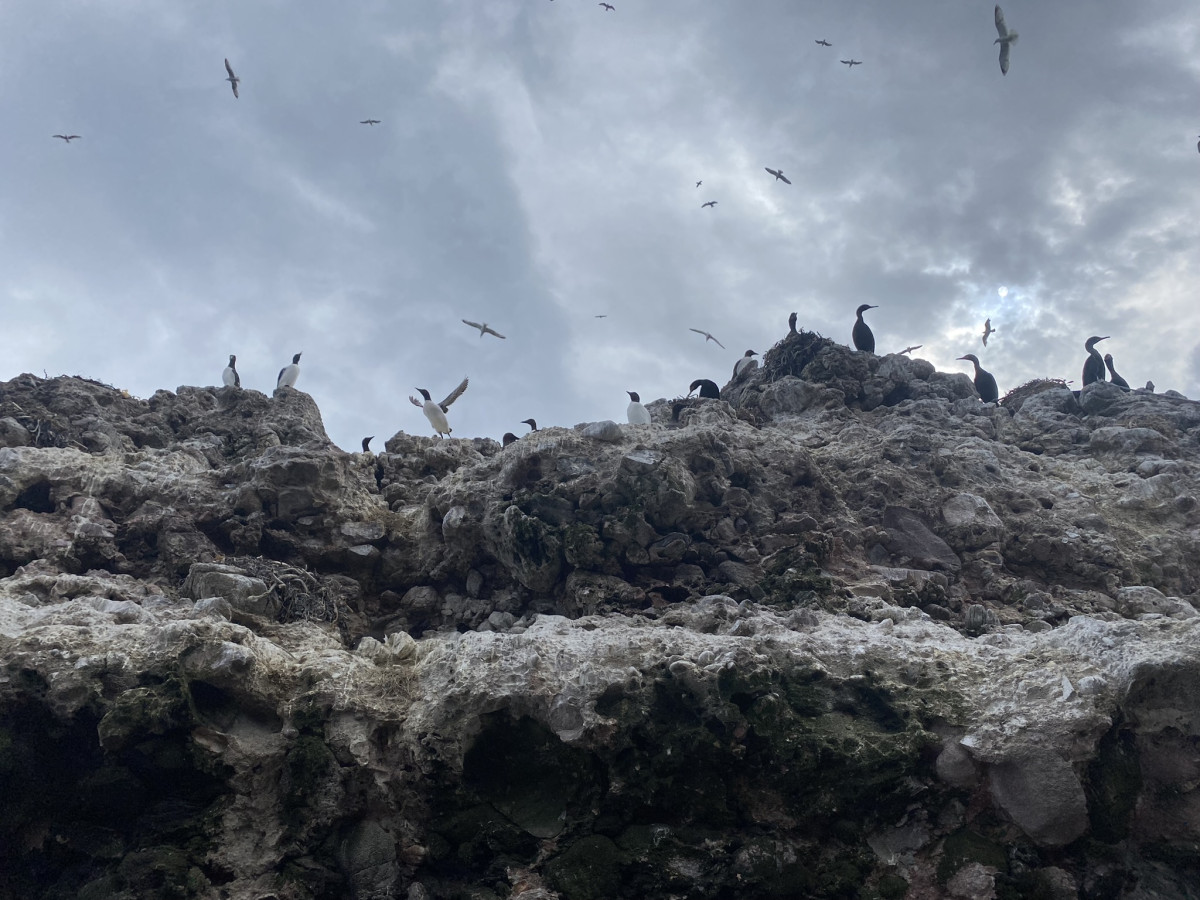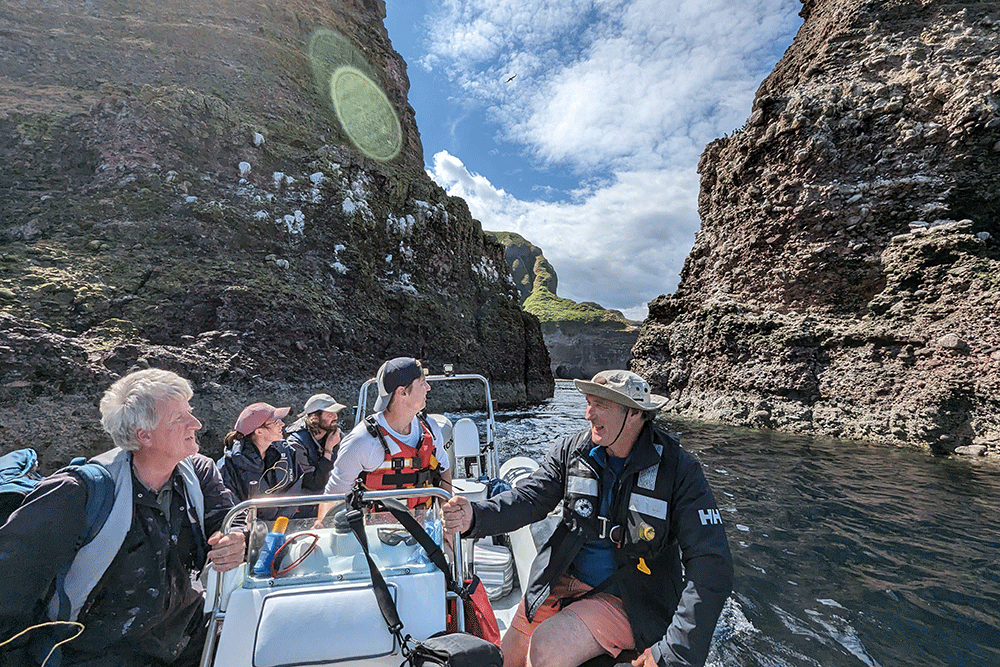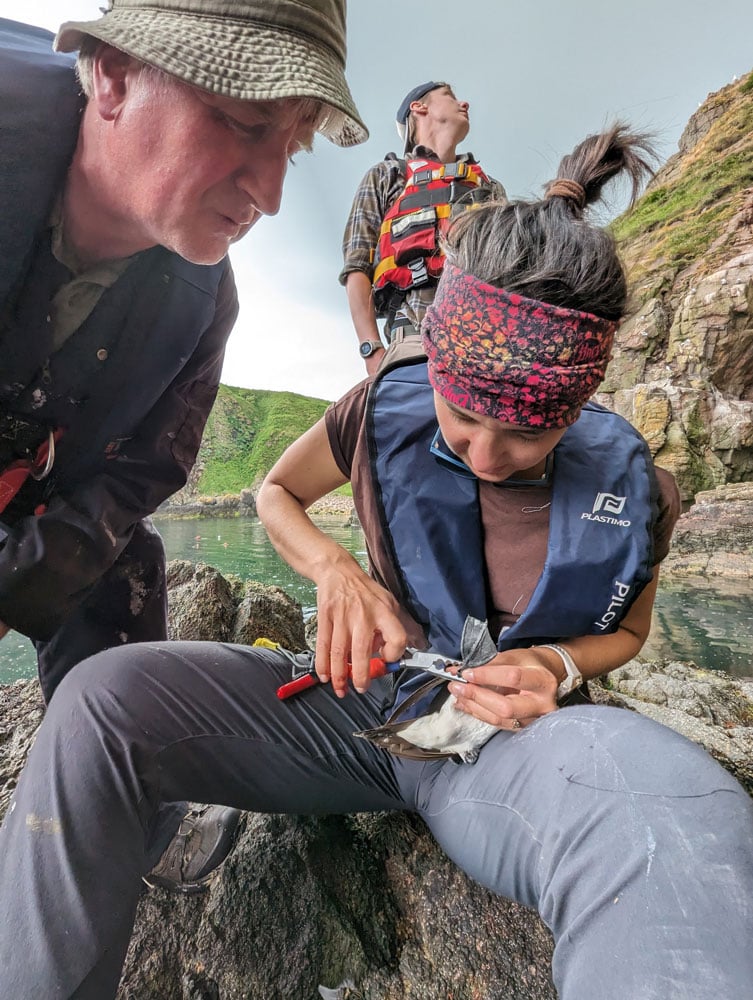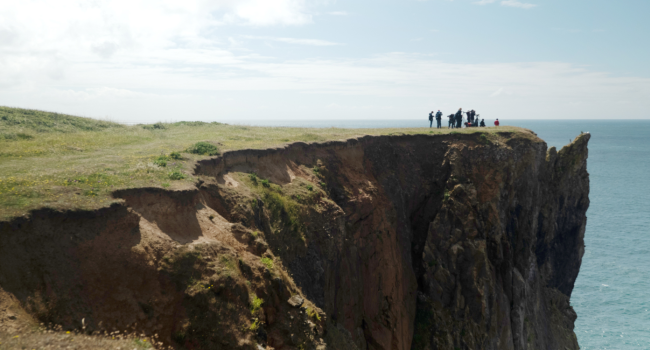
The next generation of seabird champions
It’s hard to find a place more vital, more alive than a thriving seabird colony. The sensory experience is spectacular: the constant cries and calls of thousands of birds, jostling for space on narrow cliff ledges or squabbling over the best nesting spots in the shingle; the smell of guano and fish; adults departing and arriving and feeding their young, or encouraging them to fledge. The atmosphere is vibrant and raw, with every bird focused on a single goal: to feed, protect and fledge their young.
This vitality is particularly poignant, given the ever-growing pressure our seabirds face from climate change, and other factors like avian influenza and pollution. For ecologists and volunteers who take part in fieldwork like ringing at seabird colonies, being immersed in this environment is often life-changing, and inspires a career focused on researching and protecting these amazing species.
However, it is not always easy to access training for this fieldwork. Barriers like cost, a lack of transport, and few opportunities mean that many potential seabird volunteers are unable to gain the experience they need in the field. That’s why we launched the #OurLostSeabirds appeal – to raise funds to support seabird monitoring training right around Britain and Ireland.
Seabird colonies are noisy places! In this clip, listen out for the “kitt-i-wake-kitt-i-wake-kitt-i-wake” calls that give the Kittiwake its name.
Video by Katherine Hampton.
Support for seabird ringing groups
Thanks to the many supporters who donated to the #OurLostSeabirds appeal, we have been able to develop several initiatives to boost seabird monitoring in Britain and Ireland. One such initiative is our grants for seabird ringing groups, to help them train more volunteers.
The Grampian Ringing Group received one of these grants and used the funds to support several trainee ringers to develop their seabird ringing skills. The grant also enabled the group to access a boat, which allowed them to take the volunteers to islands off the coast of Aberdeenshire where Shags breed.
“It’s very important to the group to attract new trainees and ringers. It was great seeing people getting out, and connecting with nature and the sea. The year was a tremendous success – catching over 250 seabirds including 150 Shags for a study run by the University of Aberdeen and the UK Centre for Ecology and Hydrology (UKCEH). This would not have been possible without the support of BTO.”
On this trip, with the new seabird monitoring volunteers, we really enjoyed watching everyone getting stuck in and having a great time enjoying being outside and studying seabirds.Grampian Ringing Group
Training new seabird monitoring volunteers
We have also been able to award grants to ringing volunteers looking to gain experience with seabirds who would otherwise be unable to access the training.
Alice, Katherine, Lara and Waheed, recipients of the grant, volunteered with the Grampian Ringing Group last summer and shared their amazing experiences with us.
How did you first get into ringing?
Alice: I first started ringing with the Wicken Fen Group during my undergraduate studies, having previously struggled to find a ringing trainer back home. I became interested in birds as a young teenager, and later became interested in ornithology, ecology, and conservation from a more scientific perspective. Bird ringing combined science and a love of birds and was therefore something I was keen to get involved with when I started university!
Katherine: I also started ringing as an undergraduate. I was on a conservation volunteering placement at Minsmere, where I saw the Waveney Ringing Group undertaking their weekly ringing demonstration at the site.
The next time they were attending, I arrived earlier to Minsmere than my volunteering placement began and approached some of the members who had arrived to set up the mist nets. I expressed my interest in watching them for a few hours then asked if I would be able to learn with them how to ring birds, because I had always had a passion for birds but wanted to do more with it.
I was excited to be able to spend a week by the sea, catching and ringing seabirds – being by the sea, surrounded by seabirds, is where I’m happiest!Alice
Why did you apply for a BTO seabird ringing grant?
Lara: I was keen to gain experience in ringing seabirds, as I hadn’t had the opportunity so far in my ringing. I hoped to use the experience to support other seabird ringing projects in the future.
I was also interested in making connections with other ringers and ringing groups, as well as getting more experience with large species processing in preparation for my A permit application. (An A permit holder does not have a trainer, so is entirely responsible for their own ringing activities, and they can learn how to become a ringing trainer themselves).
I was elated when I heard I had been successful. I hadn’t expected to hear back, so I’m very grateful to have been given the opportunity. A lot of the seabird ringing locations were significant journeys from where I live, so some funding towards these travel costs and accommodation allowed me to take the opportunity.
Waheed: Finding seabird ringing experience had been extremely challenging, and I had approached several seabird ringing groups in the past with limited success. This was compounded by the fact that many locations that offer seabird experiences were a significant journey away from where I live (incurring large travel and accommodation costs).
As such, I was very excited to learn about the incredible opportunity to ring species that had evaded my ringing training for almost a decade! I had also closely followed the #OurLostSeabirds appeal since its launch, and with the effects of avian influenza, for me, it had never been such an important time to apply for this grant and better understand our seabird populations.
I was delighted not only to get a place, but also for my first choice with the Grampian Ringing Group in Aberdeenshire – even if it involved a one-way trip of over 600 miles from Somerset!

The trainers were incredibly welcoming and supportive, creating an enriching learning environment. Their passion for seabird conservation was infectious, and their willingness to share expertise and guidance made the entire trip an unforgettable and delightful adventure.Waheed
What was the most memorable part of the ringing trip?
Alice: Getting back onto the boat at the end of each day and chatting and laughing with everyone as we bounced back to the harbour, tired, but eager to go again in the morning, is a fond memory. I had a fantastic time scrambling across the rocks, catching and ringing seabirds all week, but it wouldn’t have been the same without the people who made up the team – folks I hope to see again for future seabirdy adventures!
Katherine: I have always had a soft spot for Fulmars and had the opportunity to ring one for the Grampian Ringing Group’s dataset. This was truly a top moment for me which I will not forget. (It is so difficult to choose only one memory as I will not forget any of it anytime soon).
What did you learn from the experience and how will this be useful in the future?
Alice: I am currently studying seabirds as part of a PhD and hope to continue working in seabird research afterwards.
Thanks to the grant, I learnt how to noose seabirds in a safe and effective manner, which will be useful for future research I would like to undertake that will require catching cliff-nesting seabirds.
Katherine: I learnt effective ways to close larger rings under pressure and in sometimes difficult environments, and apply Darvic colour rings, something I had not done much of previously. (Darvics are coloured rings with a unique code stamped in large letters, so they are readable in the field with binoculars. Fitting them requires a different technique to standard metal bird rings.)
For part of one of the days I joined a team from BTO who were fitting radio trackers onto auks and Kittiwakes. These skills will help me when I help my own ringing group with seabird rings as I now feel more confident in fitting them.
Waheed: The ringing trip was an incredible opportunity to ring a variety of cliff-nesting seabird species, with so many skilled learned – new catching techniques, how to handle and colour-ring large species, and even cliff-climbing!
Contributing to a long-term project (with the University of Aberdeen and UK Centre for Ecology and Hydrology) also made the trip particularly worthwhile.
This experience has opened up new volunteering positions with other seabird ringing groups – for example, on Skokholm Island, Pembrokeshire, where I'm looking forward to helping with some colour-ringing projects in July 2024.
Lara: Going out on a boat each day to visit different islands, not set foot on by anything other than seabirds and seals, was very special.
I learned how to ring adult and pulli (chick) Shags, Guillemots, Razorbills, and Kittiwakes. I hope to build on this in future summers spent ringing at different seabird colonies around the UK.
Feeling inspired? Get involved!
We need more seabird monitoring volunteers to help us understand what’s driving seabird population changes and learn how we can help them.
- Volunteer for the Seabird Monitoring Programme (SMP) and count seabirds at a colony near you. Some seabird colonies are inland, so you don’t need to live near the sea to take part! Learn more about the SMP >
- If you’d like to know more about how to start seabird ringing, and maybe also receive a grant one day like Alice, Katherine, Lara and Waheed, learn more about starting seabird ringing >
- If you’d like to get involved in ringing other birds but don’t yet have a permit, find out more about training to ring >












Share this page